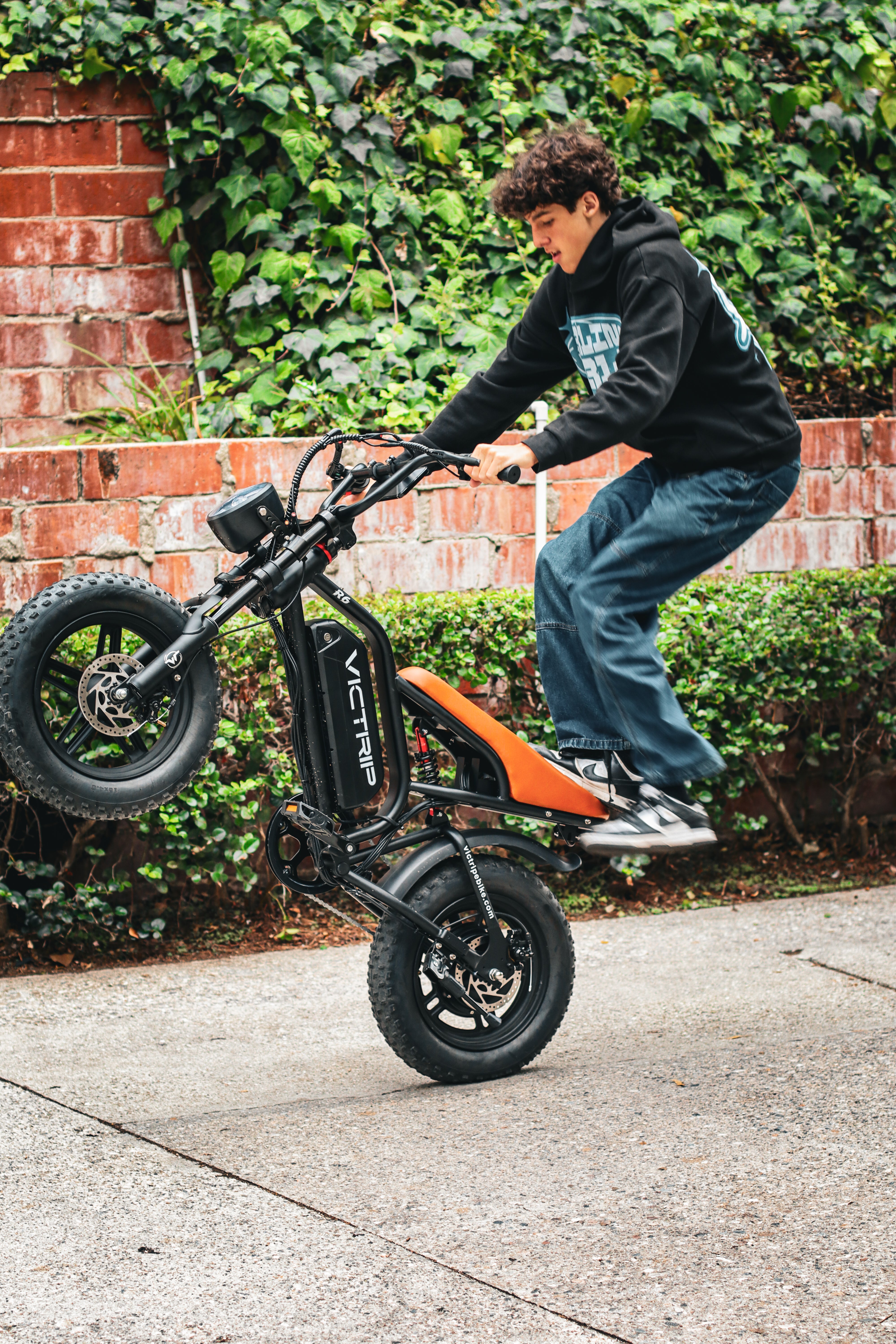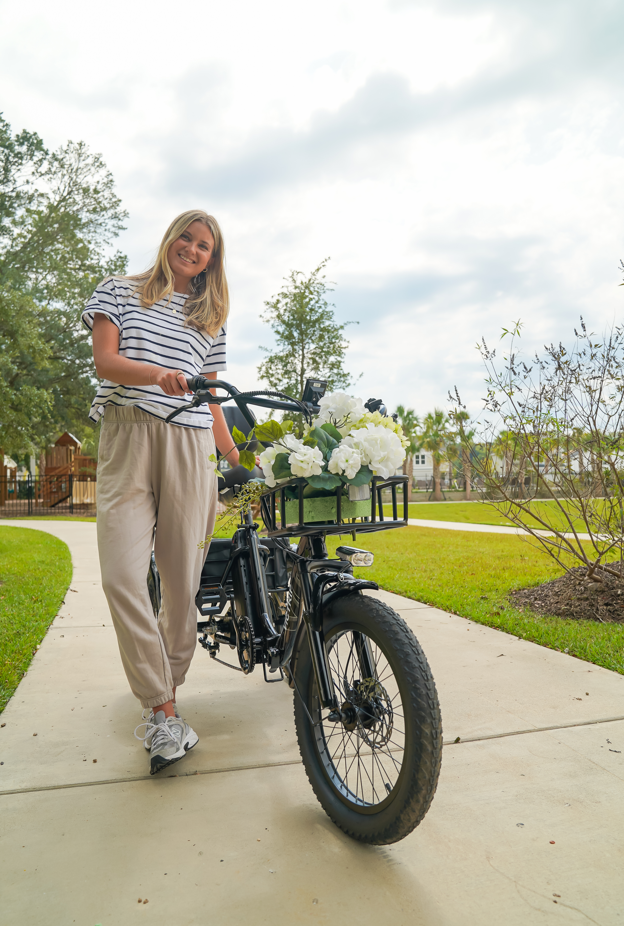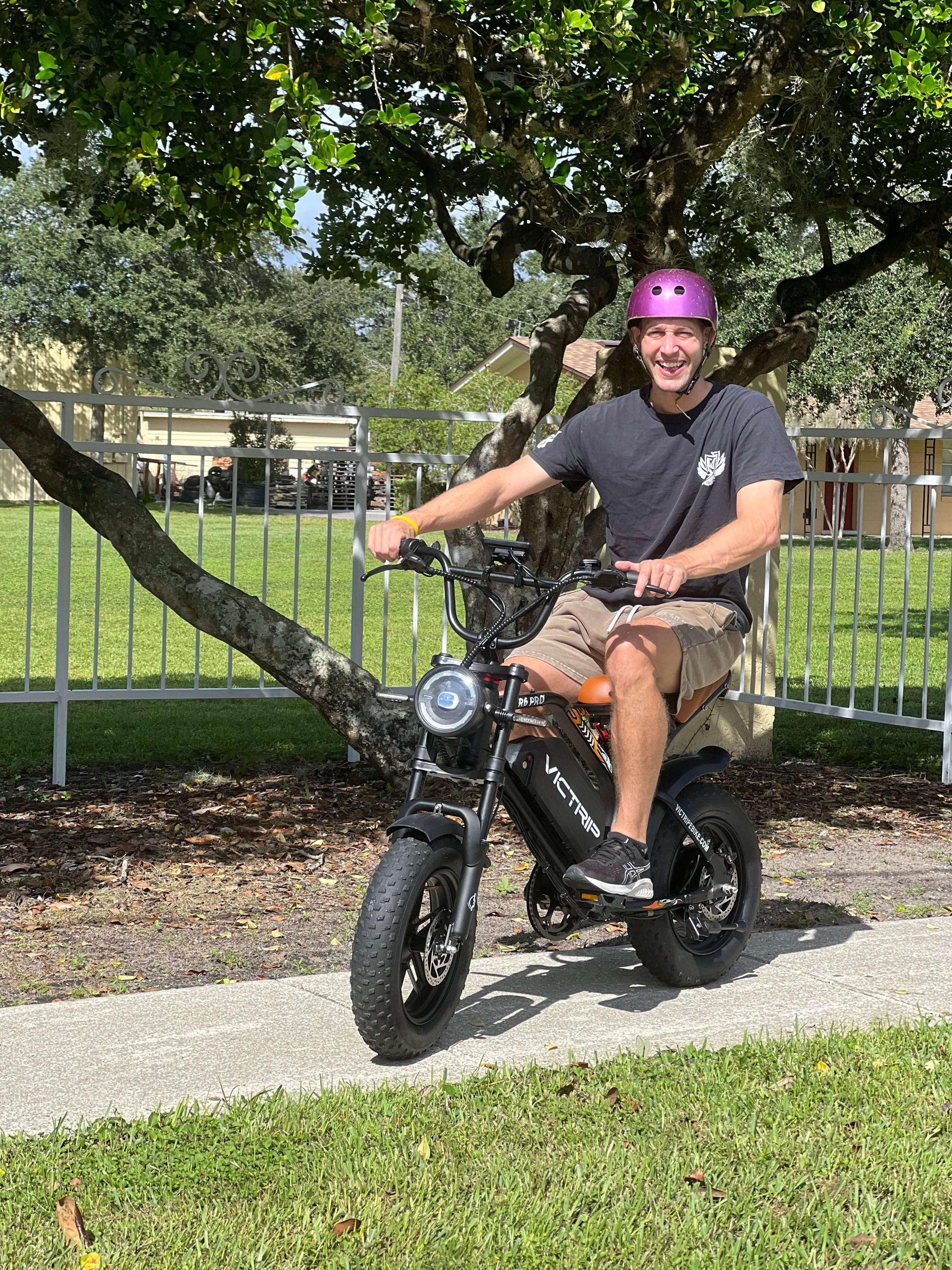If you're shopping for your first electric trike, this guide will walk you through the critical choices and eight common mistakes most buyers make. You'll get clear, practical advice, a seven-step buying checklist, maintenance tips, accessory recommendations, and FAQs. The goal: help you buy smarter, ride safer, and get the best value.
Why choose an electric trike? Pros & who benefits
An electric trike blends the stability of three wheels with the convenience of electric assist. It's a great pick if you want a steady ride for errands, a cargo-hauling commuter solution, or an accessible option for riders who struggle with balance.
Key benefits include:
-
Stability: no wobble when stopped; easier mounting/dismounting.
-
Cargo capacity: many trikes carry heavier loads than bikes.
-
Comfort: more upright seating and ergonomic advantage.
-
Accessibility: ideal for older riders or those with mobility issues.
One standout model that demonstrates these advantages perfectly is the VICTRIP T1. It combines ergonomic comfort with stable handling and powerful electric assistance, making it a top choice for urban riders and seniors seeking effortless mobility. Its wide base and balanced design allow confident riding even on uneven terrain.
Who benefits most? Urban commuters with groceries, small business owners making local deliveries, people with balance concerns, and recreational riders who value comfort. For these users, an electric trike often beats a standard e-bike because it's easier to handle and can carry more.

The three trike archetypes (delta, tadpole, cargo)
-
Delta trikes: two wheels at the back, one at the front. Easier to manufacture, usually upright and cargo-friendly.
-
Tadpole trikes: two wheels at the front, one back. They corner better and often feel sportier.
-
Cargo trikes: built specifically to carry goods; may have long tails or large front boxes.
Regulations & where you can ride
Rules vary by jurisdiction. Some cities treat e-trikes like bicycles; others may limit them to bike lanes or paths. Always check local rules and confirm whether a Class-1/Class-2 classification applies (pedal-assist vs throttle). Also check helmet laws and any speed caps.
Core components explained: motor, battery, controller
When you compare models, resist judging by paint or price alone. The three parts that dictate performance are the motor, the battery, and the controller. Get these right and you’ll have a trike that serves you for years.
Batteries: capacity, chemistry, and range estimates
Battery specs are often shown as voltage (V) and amp-hours (Ah). Multiply V × Ah = watt-hours (Wh), the key indicator of energy. For example, a 48V × 10Ah pack = 480Wh. Range depends on rider weight, cargo, terrain, assist level, and weather.
-
Expect city/flat commutes: 20–50 miles per charge on typical packs.
-
Heavy cargo or hilly routes: range drops significantly.
Battery type matters: Lithium-ion (Li-ion) variants are the standard. They offer good energy density and longevity. Avoid unknown chemistry with no specs.
Motors: hub vs mid-drive
-
Hub motors: simpler, more common on trikes. Quiet, lower maintenance, but less efficient on hills.
-
Mid-drive motors: sit near the crank and use the drivetrain. Better torque for climbing and payloads but more complex and sometimes pricier.
Pick motor power by intended use. For cargo or hilly routes, look for higher torque (e.g., 250–750W continuous; peak numbers vary).
Read More: Hub Drive vs Mid Drive: Which eBike Motor Is Better?
The 8 mistakes new buyers make (detailed)
This is the heart of the guide. Below we unpack the eight mistakes and show how to avoid them. Each subsection explains the error, the consequence, and the fix.
Mistake 1: Choosing by price alone
It’s tempting to pick the cheapest trike that looks decent. But low price often hides compromises: thin tires, weak brakes, limited battery life, or nonexistent support.
Why it matters:
-
A cheap controller or battery will fail sooner.
-
Replacement batteries can cost as much as you saved.
Fix:
-
Compare build quality, frame warranty, and service support.
-
Factor in total cost of ownership: battery replacement, tires, brakes, and service.
Mistake 2: Ignoring payload & real-world range
Manufacturers publish range in ideal test conditions. Real-world range falls short if you add cargo or ride hilly routes.
Why it matters:
-
You may be stranded if the battery can't carry you and your load.
-
Overloading a trike reduces motor/battery life.
Fix:
-
Use a conservative estimate: cut advertised range by 30–40% for planning.
-
Calculate expected payload: rider weight + cargo + accessories = total load.
-
Choose a battery with extra capacity or plan for frequent charging.
Mistake 3: Skipping a test ride
You can’t judge how a trike handles from photos. Fit, steering feel, and seating comfort vary widely.
Why it matters:
-
A trike with wrong ergonomics can cause back or neck strain.
-
Handling quirks only reveal themselves in motion.
Fix:
-
Always take a test ride with a typical load.
-
Try different seat heights and adjust handlebar positions.
-
If buying online, confirm a fair return policy.

Mistake 4: Overlooking brakes & safety kit
A heavy trike with cargo needs strong brakes. Many buyers assume standard brakes are fine—until emergency braking.
Why it matters:
-
Weak braking increases stopping distance dramatically.
-
Safety accessories (lights, mirror, horn) are essential for visibility.
Fix:
-
Prefer hydraulic disc brakes or well-rated mechanical discs.
-
Add quality lights (front & rear), reflective tape, and a mirror.
-
Consider an anti-tip kit if you'll carry high loads.
Mistake 5: Neglecting service & spare parts
Some manufacturers are great at shipping trikes but fail at after-sales parts. If a unique frame part breaks, repairs can be hard.
Why it matters:
-
Downtime equals lost utility and wasted money.
-
Non-standard parts increase repair time and cost.
Fix:
-
Choose brands with clear warranties and local dealer networks.
-
Check availability of batteries, motors, and replacement wheels.
Mistake 6: Buying wrong battery type
Not all batteries are created equal. Also, airline or postal rules may restrict certain chemistries or sizes.
Why it matters:
-
If you plan to travel with your trike or ship it, some batteries aren’t allowed.
-
Cheap cells degrade faster and hold less charge.
Fix:
-
Look for reputable cell makers (e.g., LG, Samsung).
-
Confirm whether the battery is removable for safe charging.
-
Verify airline/transport rules before traveling.
Mistake 7: Misjudging terrain suitability
Not every trike is fit for every road. Some lighter trikes struggle on gravel or steep hills.
Why it matters:
-
Unsuitable tires and low-power motors reduce safety and comfort.
-
You may have to push the trike uphill—defeats the purpose.
Fix:
-
Match the trike to your terrain: narrow tires for smooth roads, wider tread for rough surfaces.
-
For steep terrain, choose higher torque motors and lower gear ratios.
Mistake 8: Not planning for storage & charging
Where will you charge and store your trike? Many buyers overlook theft prevention or safe charging locations.
Why it matters:
-
Improper storage shortens battery life (extreme temps).
-
Unsecured trikes get stolen.
Fix:
-
Store indoors or use a weatherproof cover.
-
Keep battery at ~40–80% if storing long-term.
-
Invest in a good lock and consider GPS trackers for high-value units.
How to choose: a practical 7-step checklist
This is your action plan. Complete these steps before you commit.
-
Define needs & daily route — distance, cargo, hills, typical speed.
-
Set a realistic budget — include extras and potential battery replacement.
-
Prioritize essentials — battery capacity, brakes, motor torque, frame strength.
-
Test-ride candidate models — with a load if possible.
-
Inspect build & warranty — frame warranty and battery warranty are musts.
-
Confirm service network — local shop support cuts downtime.
-
Buy accessories up front — good lights, helmet, and a quality lock.
During the decision phase, many riders discover that modern, well-balanced trikes such as the VICTRIP T1 electric trike meet all seven criteria gracefully. It offers long range, solid braking performance, and dependable after-sales support—making it an ideal benchmark for first-time buyers comparing electric trike options.
TOP PICK

VICTRIP® T1 Foldable Electric Tricycle
$1,299.00
Maintenance, charging, and ownership costs
Owning an electric trike means periodic maintenance. Below is an approachable cost and maintenance guide.
Typical ownership costs (annual estimates):
-
Tires & tubes: $30–$120
-
Brake pads/rotors: $30–$150
-
Battery top-up / replacement reserve: $50–$200/year saved for future replacement
-
General service (tune-up): $50–$150
Simple maintenance schedule (table)
| Task | Frequency | Why it matters |
|---|---|---|
| Tire pressure check | Weekly | Proper pressure improves efficiency & range |
| Brake inspection | Monthly | Ensures stopping power and safety |
| Chain/drivetrain lubrication | Monthly (or after wet rides) | Smooth shifting & motor efficiency |
| Battery health check | Every 3 months | Early detection of capacity loss |
| Full service | Annually | Keeps everything in warranty-friendly condition |
Routine care extends battery life and reduces long-term costs. Don’t let dust and moisture build up; wipe down regularly and store dry.
Safety checklist & recommended accessories
Safety is non-negotiable. Here are recommended items that pair well with an electric trike:
-
Helmet — choose a certified helmet fit for three-wheel dynamics.
-
Lights — bright front headlamp (500+ lumens), flashing rear light.
-
Reflective gear — vest or tape for night visibility.
-
Mirrors — helps with lane changes and awareness.
-
Rack/box — secure cargo with locking boxes if possible.
-
Good lock + GPS tracker — deter and recover theft.
Quick comparison table: commuter vs cargo vs recreational
| Feature | Commuter Trike | Cargo Trike | Recreational Trike |
|---|---|---|---|
| Typical battery | 400–600Wh | 600–1000Wh | 300–600Wh |
| Motor | 250–500W | 500–1000W | 250–500W |
| Load capacity | Moderate | High | Low–moderate |
| Best for | Urban rides, errands | Deliveries, heavy loads | Leisure, trails |
| Weight | Lighter | Heavier | Moderate |
Use this table to align your use-case with the right platform.
Final verdict & resources
Buying an electric trike can transform short trips into effortless outings. To recap: avoid the eight common mistakes—especially choosing by price alone, underestimating payload effects, and skipping a test ride. Use the seven-step checklist before buying, and factor in maintenance and safety.
For further reading on safety standards and general guidance about e-mobility, check reputable resources such as Consumer Reports or your local transport authority.
FAQs
How far can an average electric trike go on a single charge?
Typical ranges vary widely. With a 400–500Wh battery you might see 20–40 miles under normal city conditions. Expect less with heavy cargo or hills. Always plan conservatively.
Do I need a license or registration for an electric trike?
Mostly no—many places treat electric trikes like bicycles. However, local rules differ, so check municipality regulations. If the trike exceeds certain speeds or power levels, registration might be required.
Can I ride an electric trike in the rain?
Yes, most modern e-trikes handle light rain, but avoid deep puddles and extended exposure. Dry the drivetrain after wet rides and store the battery inside.
How long do trike batteries last?
With good care, lithium batteries typically last 3–7 years depending on charge cycles and storage. Avoid extreme temperatures and charge between 20–80% when storing.
Is it hard to maintain an electric trike?
Not really. Routine checks (tires, brakes, chain) and periodic servicing keep it in top shape. Having a local shop that knows e-trikes helps greatly.
Can I add an electric motor to a regular 3-wheel trike?
It's possible, but conversion kits vary in quality and may affect reliability. For safety and warranty reasons, buying a purpose-built electric trike is often better.




Share:
Why Battery Capacity Matters More Than Motor Power?
How to Ride Your EBike Safely in Winter?